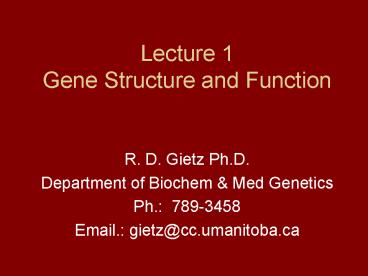Lecture 1 Gene Structure and Function - PowerPoint PPT Presentation
1 / 30
Title:
Lecture 1 Gene Structure and Function
Description:
To understand the structure of DNA and how it is replicated. ... Information in DNA is accessed by transcription. This is done by copying the DNA strand into RNA. ... – PowerPoint PPT presentation
Number of Views:4839
Avg rating:3.0/5.0
Title: Lecture 1 Gene Structure and Function
1
Lecture 1Gene Structure and Function
- R. D. Gietz Ph.D.
- Department of Biochem Med Genetics
- Ph. 789-3458
- Email. gietz_at_cc.umanitoba.ca
2
- Learning Objectives
- To understand the structure of DNA and how it is
replicated. - To understand the structure of a gene.
- To understand the Central Dogma of Molecular
Genetics - To understand the how the genetic code is used.
- To understand how proteins are produced
modified.
3
DNA is made up of phosphodiester bonds linking
2 deoxyribose sugars. Each sugar is linked to a
nitrogenous base that provides the information
coding part of the molecule.
4
The nitrogenous bases come in 4 varieties.
Adenine, which pairs with Thymidine, Guanine
which pairs with Cytosine. Note the two hydrogen
bonds between AT and three between GC.
5
DNA structure. DNA is double stranded with the
bases being on the inside of the molecule. The
strands are anti-parallel. (polarity)
6
Hydrogen bonding can cause hairpins in DNA and RNA
7
DNA is replicated semi-conservatively. This is
what gives replication its high fidelity. One
strand is old and one strand is new produced by
copying from the complementary sequence.
8
DNA replication is difficult due to anti-parallel
nature of the molecule. Replication can only
occur in one direction in a biological system.
That is 5 to 3.
9
DNA replication is accomplished by DNA
polymerases. In Mammals there are 5, each with a
different job.
10
The central Dogma of Molecular Genetics
11
Information in DNA is accessed by transcription.
This is done by copying the DNA strand into RNA.
12
Transcription is regulated by a promoter elements
that bind protein transcription factors.
13
Some promoter elements and Transcription Factors
that control gene expression
14
Genes in Humans are not contiguous. Genes are
made up of Exons (coding) and Introns (non
coding). Introns must be removed.
15
Splicing signals are found in the gene sequence.
The consensus sequences is found at the
exonintron boundaries as well as in the intron
at the Branch site.
16
Splicing mechanism
17
RNA is modified to make it more stable. One way
is 5 cap
18
mRNA is polyadenylated after transcription. Aids
in transport to the cytoplasm, mRNA stability,
and enhanced recognition by ribosomes
19
Genes and Proteins are co-linear. Genes are
processed by splicing. Proteins are processed by
cleavage and modification.
20
Translation occurs from the 5 end to the 3 end
giving a colinear protein.
21
Peptide bond
Universal Genetic Code
The 5 end of the gene is the same at the N
terminus of protein.
22
Gene and protein co-linearity. Gene and protein
processing
23
Proteins are modified after production.
24
Proteins are localized into different cellular
compartments by signals that are found within the
primary sequence.
25
Protein secondary structure. Alpha helix and
beta sheet.
26
Proteins have 4 levels of structure
27
Proteins can have more complex structures
covalent interactions between subunits as well as
tertiary and quaternary structures.
28
Summary 1
- DNA is double stranded.
- Phosphodiester bonds between deoxyribose sugars
give backbone. Bases are attached to the sugars
and are complementary AT GC - Information is encoded by the linear sequence of
the bases. - DNA is replicated 5-gt 3
- Information flows from DNAlt-gtRNA-gtProtein
29
Summary 2
- Genes are a linear array of 4 nucleotides
- In mammals genes are non contiguous
- Information accessed by making RNA copy
- Transcription controlled by up stream cis acting
elements and proteins that bind to it. - Exons are fused at the RNA stage by splicing
which removes the introns - RNA is modified by a Cap and polyadenylation
30
Summary 3
- Genes and proteins are co-linear
- Triplets are converted into amino acid sequence
- Proteins are modified in numerous ways post
production.





























![[I] MCB 3201 Gene Expression PowerPoint PPT Presentation](https://s3.amazonaws.com/images.powershow.com/7443564.th0.jpg?_=20151207088)

